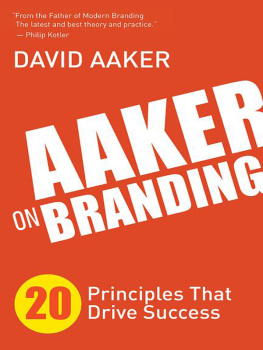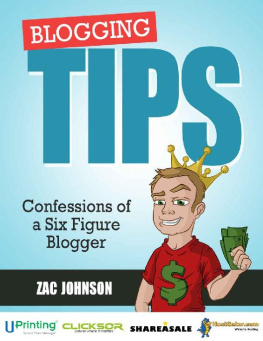
Special Thanks to:
Emily Rapp
http://ouriittieseai.wordpress.com Little Seal
Pamela Wilson
http://www.bigbrandsyst.em.com Big Brand Systems
Liz Strauss
http://www.successful-blog.com Successful-Blog
Zac Johnson
http://zacjohnson.com zacjohnson.com
Rosalind Gardner
http://rosalindgardner.com, Rosalind Gardner
Michela Chiudili
webislove.com Web is Love
Robin Callan
http://roomfu.com/biog Fu For Thought
Andrew Boer & Andrew Elsner
http://www.movablemedia.com Movable Media
Jay Johnson
http://www.design2share.com Design2Share
Design, Layout, and Text copyright New York Institute of Career Development 2013
All rights reserved. Copyright under Berne Copyright Convention, Universal Copyright Convention, and Pan-American Copyright Convention. No part of this book may be reproduced, stored in a retrieval system, or transmitted in any form, or by any means, electronic, mechanical, photocopying, recording, or otherwise, without prior permission of the publisher.
13 14 15 16 17 18 19 20 21 22 10 9 8 7 6 5 4 3 2 1
Published by Allworth Press
An imprint of Skyhorse Publishing, Inc.
307 West 3th Street, 11th Floor
New York, NY 10018
www.skyhorsepublishing.com and www.allworth.com
Allworth Press books may be purchased in bulk at special discounts for sales promotion, corporate gifts, fund-raising, or educational purposes. Special editions can also be created to specifications. For details, contact the Special Sales Department, Allworth Press, 307 West 36th Street, 11th Floor, New York, NY 10018 or info@skyhorsepublishing.com.
Copublished by New York Institute of Career Development.
New York Institute of Career Development is a registered
trademark of Distance Education Co. LLC in the United States
and/or other countries
211 East 43rd Street, Suite 2402
New York, NY 10017
www.nyicd.com, blog.nyicd.com, and www.decnyc.com
Cover and Interior Page Design by Keith Gallagher
Editorial Writing by Zach Heller
Editing by Steven Evans
Preface by Andrew Boer
NYICD Publisher: Jay Johnson
NYICD Director: Chuck DeLaney
Library of Congress Cataloging-in-Publication Data has been applied for and is on file with the Publisher.
ISBN: 978-1-62153-248-4
Printed in China.
CONTENTS

PREFACE
The Valuation of Content
By Andrew Boer
President, Movable Media
S pend some time on any New England beach and some well-meaning soul may point out that the beautiful purple-tinged Quahog clam shells strewn across the sands were once used as currency by Native Americans. But even a child can quickly appreciate why wampum beads were not destined for greatness: theyre a plentiful resource that once required intensive labor to convert into beads. But with modem tools, theyd require relatively little effort to manufacture and duplicate.
In our modem content economy, words have become wampum. Words, generally speaking, are increasingly cheap to produce and available in a seemingly infinite supply. Words are now manufactured into content on a massive scale by both humans and computers alike. Content has become so devalued that the most successful publishers in the past decade have been those whose business models revolve around paying nearly nothing for content.
The resulting explosion of cheap, mediocre content has meant that as readers, weve become awash in noise.
And many content creators are now as nervous as a 17th century clamdigger. We think at least part of the problem is how content is currently valued: a word count makes a lousy predictor of value.
Like wampum, a word count is a kind of proxy for the cost of creation, the time and craft of the creator. In the print journalism world, a cost-based approach to content made sense. An article of 500 words might be a perfectly acceptable predictor of value if the article filled a certain amount of physical space in a publication that was accompanied by paid ad pages or subscription revenue. Individually, the article might have very little measurable effect on the overall revenue of the publication.
Online content, however, is a different beast. It tends to stand alone and generate revenue independently of the rest of the content.
When it comes to revenue (value), one 500-word article is simply not like another.
Of course, publishers and authors arent truly pricing by the word. They try to use other proxies to determine a fair price, including the subject matter, the market rate, and the reputation, experience, and expertise of the author. But these intangibles also make poor containers of value, in the sense that theyre also not helpful in predicting whether an article will find an audience.
If a publisher cant predict the revenue a 500-word article will create based on quality or reputation, they eventually turn to price to choose a content provider. As cheaper alternatives enter the market, prices for content rapidly start to decline.
All of this has been happening in the publishing world for the past ten years, and its painted a fairly grim picture for bloggers and other content creators and publishers alike: lower wages and more noise.
But in the past couple years, a new and predictable way to value content has emerged thats transforming the content economy. Many bloggers have begun to develop a built-in following through social networks and search engines, which are becoming a legitimate new channel for content distribution. We call this the Author Channel.

THE AUTHOR CHANNEL
With the advent of social media and author ranked search, authors (thats you, if youre a blogger) now have a surprising amount of control, in aggregate, over content distribution. On sites like Forbes.com, over 50% of the traffic now comes from the audiences of its own contributors.
Authors now have the ability to build audiences on their own blogs and move them, which allows them to predictably affect the value of their content. Soon theyll be compensated according to tangible yardsticks of value such as audiences and engagement, and per-word pricing will disappear.
The beauty of this new author channel is that it realigns the value created by authors and bloggers with the value captured by publishers and brands.
Theyre now both speaking the same language.
This may also help solve the noise problem, as the audiences of successful creators grow in direct proportion to the authors quality and expertise. Indeed, the search engines are beginning to focus on signals like Author Rank and engagement instead of Page Rank to determine the primacy of content.
Soon publishers will work with bloggers to develop market rates not for the words of the content they create, but for the attention of the audience they hope to bring. While this model of performance-based entrepreneurial journalism was pioneered at the low end by search-based content farms like Demand Media, incentive-based compensation actually turns out to be most effective for premium content creators such as
Next page


















